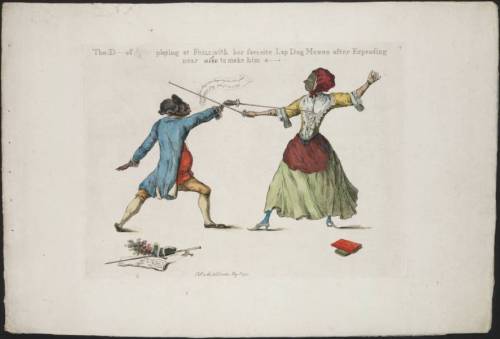medievalpoc:Julius Soubise, Macaroni of LondonJulius Soubise (1754-1798) was the adopted son of the
medievalpoc:Julius Soubise, Macaroni of LondonJulius Soubise (1754-1798) was the adopted son of the infamous Catherine Hyde, Duchess of Queensbury (1701-1777), who was a wealthy and scandalous eccentric. He was born at St. Kitts and arrived in London at the age of ten. His good looks generated a good deal of interest among women of rank, and Soubise came to live with the Duchess in 1764.Raised in privilege, Soubise excelled at violin, acting, and oration; he also became the Duchess’s riding and fencing master as a young man. Although Soubise’s presence in the household was met with the Duke of Queensbury’s approval and encouragement, rumors that a sexual relationship existed between The Duchess and her fencing master pervaded London high society; the top engraving (William Austin, 1773) is a satirical allegory alluding to that relationship. Gerzina (1995) relates the manner in which the popular young man was received by London society in adulthood: Soubise ‘suddenly changed his manners, and became one of the most conspicuous fops of the town. He frequented the Opera, and the othertheatres; sported a fine horse and groom in Hyde-Park; became amember of many fashionable clubs, and made a figure.’ Soubise became quite accustomed to spending money on clothing, fine dining, and women friends; the prominent Black British academic and abolitionist Ignatius Sancho wrote a letter addressed to him in 1771 entreating the wildly popular fop to tone down his behavior and appeal to respectability. He did not take this advice.Another engraving of Soubise labels him “A Mungo Macaroni”. “Mungo” refers to a much-maligned Black character in a contemporaneously popular play; “Macaroni” being a 17th Century term for wealthy young men obsessed with (usually French) fashion, gambling, drinking, and generally engaging in dissolute behavior. Julius Soubise continued his lavish and decadent lifestyle in London with the blessing of his patron until her death in 1777. Accounts vary as to which event came first, but it is clear within a day or two of the Duchess’s demise, Soubise was accused of assaulting a young woman who worked as a maid, and subsequently fled to Calcutta in Bengal, India. He founded an equestrian school there and spent the rest of his days training young men and women to ride and fence. Julius Soubise died at 44 years of age on August 25, 1798, from injuries sustained by a fall from a horse. Further Reading:The Limits of the Human: Fictions of Anomaly, Race and Gender in the Long Eighteenth Century; Felicity Nussbaum (p. 6-8)Unchained Voices: An Anthology of Black Authors in the English-Speaking World of the 18th Century; Vincent Carretta Black London: Life before Emancipation, Gretchen Holbrook Gerzina. Rutgers University Press, 1995. The Letters of the Late Ignatius Sancho, an African; Ignatius Sancho (Edited by Vincent Carretta) (1998). Penguin Classics. p. 257 -- source link
#amazing#fencing#dancing#race#gender#scandal#history#18th century#london#queue


